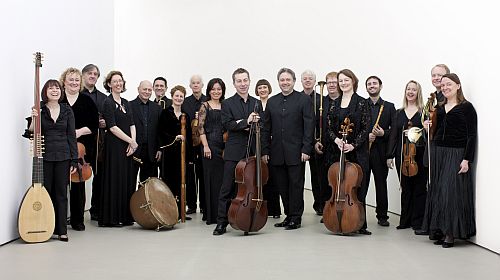 United States J. S. Bach: Academy of Ancient Music, Richard Egarr (Director and Harpsichord), Zankel Hall, Carnegie Hall, New York, 7.11.2014 (SSM)
United States J. S. Bach: Academy of Ancient Music, Richard Egarr (Director and Harpsichord), Zankel Hall, Carnegie Hall, New York, 7.11.2014 (SSM)

Orchestral Suite No. 4 in D Major
Orchestral Suite No. 2 in B Minor
Orchestral Suite No. 1 in C Major
Orchestral Suite No. 3 in D Major
It would be hard to overstate the impact on early music practice that Christopher Hogwood and the Academy of Ancient Music had when they released their initial recordings of what eventually became the complete Mozart Symphonies. In the early 1970s, there were a number of groups playing, to varying degrees, in an early music style. Some, like I Musici, performed as a Baroque band but played on new instruments. Concentus Musicus Wien and the Leonhardt-Consort used Baroque instruments or copies of them in their recording of the complete Bach Cantatas.
The Bach Cantata series might have been a little abstruse to appeal to many concert goers and record buyers, particularly the first ones which came out as LPs with the complete scores enclosed. The series took 18 years to complete and now exists in a boxed set of 60 CDs. By comparison, the AAM Mozart series required only 19 CDs and 7 years to complete.
What Hogwood and the the AAM did was to set the standard for how to get as close as possible to what music might have sounded like to a composer of early music. Scholarly research was done so that where possible every symphony was traced back to its original source; and attempts were made to replicate the number of instruments and of players in the first performance. The result of this practice was music that was fresh, clear and clean.
The number of early music specialists who were part of the AAM and went out on their own is stunning. Just the list of conductors who formed their own Baroque groups is impressive: Simon Standage, Roy Goodman, Monica Huggett, John Holloway, Nicholas McGegan, David Woodcock and Simon Preston among them.
Richard Egarr, the current director and conductor of the AAM, continues the Hogwood tradition. In his brief remarks before the concert, Egarr prepared the audience for the sounds to follow. By lowering the pitch and using one voice per part (OVPP), the music would sound softer and darker than what one expects when hearing these suites, and it did indeed.
The Bach Orchestral Suites are cousins to the Brandenbergs, though it’s not surprising that they are rarely performed as a set. The latest research has shown that they were not all written in the 1720s and composed as a whole; two came later, the Third Suite ca. 1731 and the Second in 1738-39. The ordering of the pieces for this performance was clearly done for aesthetic reasons, at least in the choice of the Third to end the program. The Third has most of the players onstage and also uses the brass to great effect, going out with a flourish.
Although there is variety in the Suites’ dance movements, they can start sounding the same. This wasn’t a problem here. Each movement had its own coloring, enhanced by the fact that with a small ensemble no one instrument can overpower the soloist. Egarr, playing from the keyboard (as support for the basso continuo), kept a moderate pace throughout and was clearly well-attuned to the Suites’ nuances.
Pavlo Beznosiuk, a Baroque violin virtuoso in own right, added tasteful ornamentation to a number of the da capo iterations, noticeably in the doubles in the Menuet and Passepied of the First Suite, as well as the da capos of the famous Air from the Third Suite. Bassoonist Ursula Leveaux did an unusually good job supporting the bass line, and in her solo parts as well. The three oboists, Frank de Bruine, Lars Henricksson and Gail Hennessy, had some intonation problems and an occasional slip-up getting back from the da capos, but overall they were impressive.
I listened again to a performance of the Suites recorded in the early 1960s which was my introduction to the works. There certainly was some good playing, but without the dotted rhythms, vibrato-less strings and easement of four-square playing. Today we accept historically informed performance (HIP) as the norm for most early music, and even non-Baroque orchestras concede to some of the tenets discussed here. We should be thankful for the work done by Hogwood and the AAM in mentoring a whole generation of musicians who have promulgated an approach that has brought back to life music that might otherwise never have been heard.
Stan Metzger
